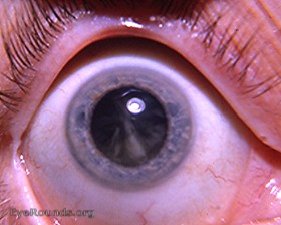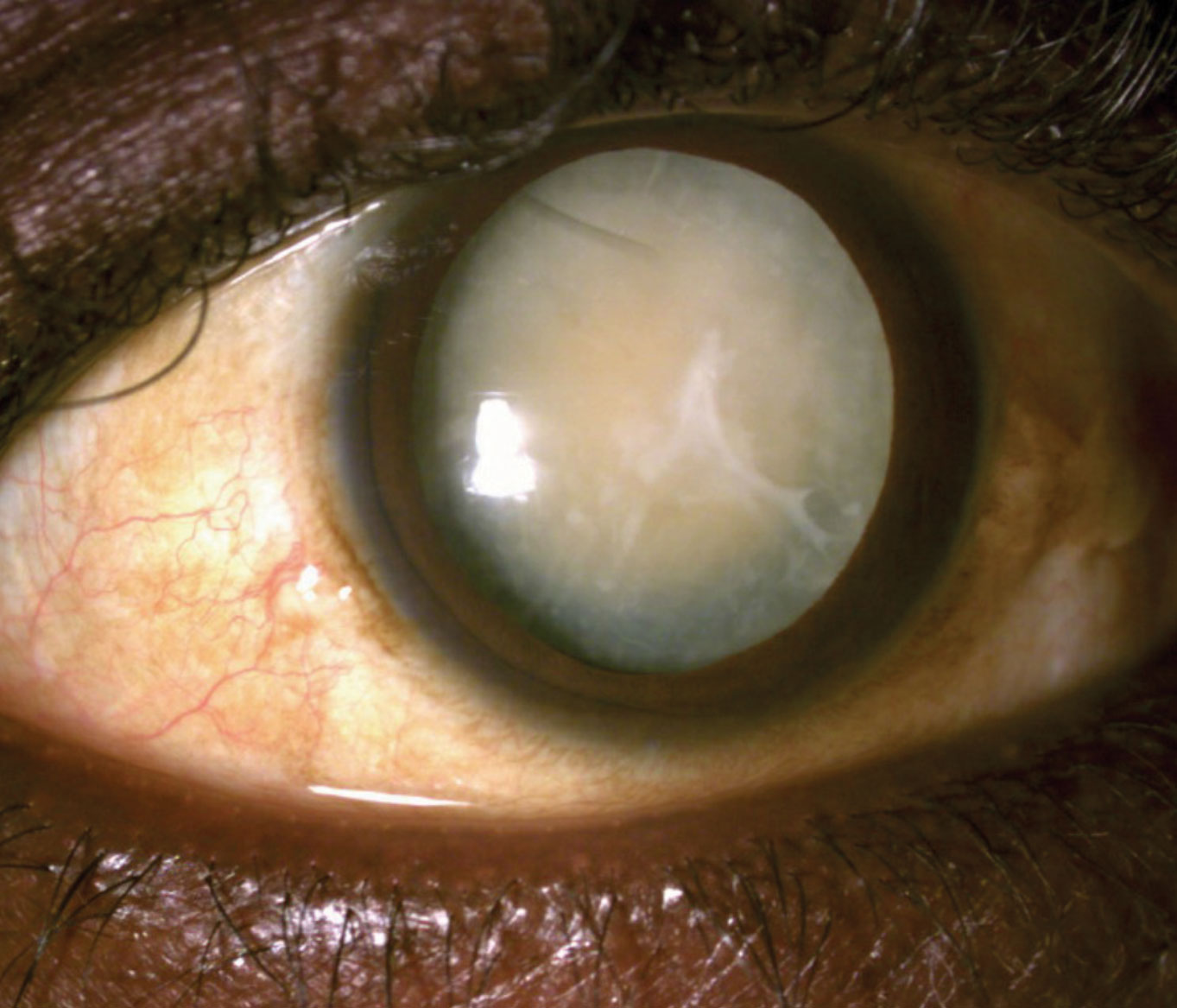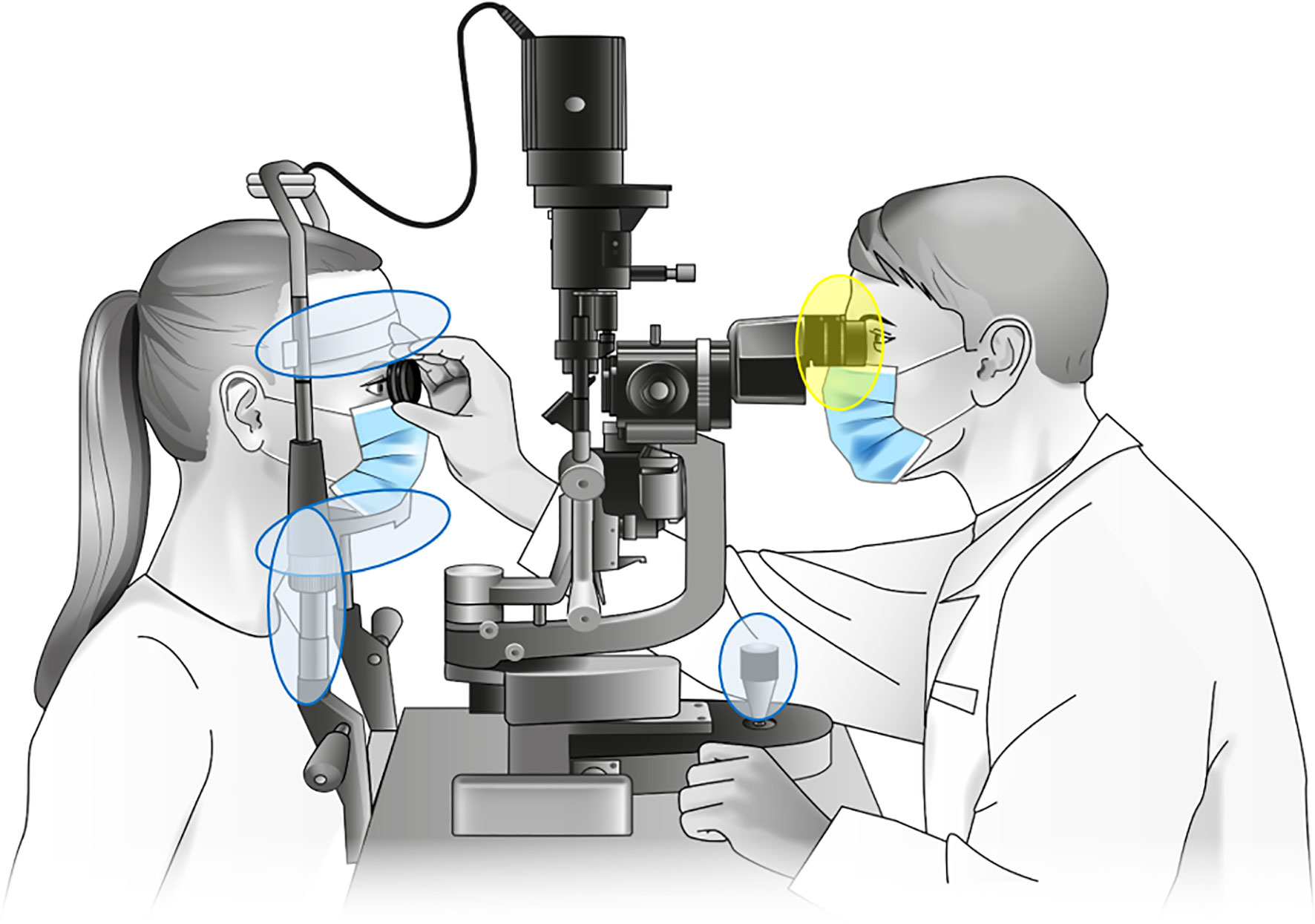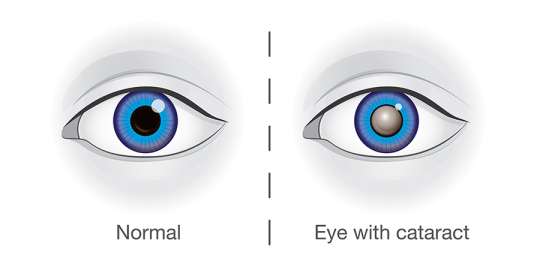Table of Contents
ToggleCataract
Cataract is lens opacity or cloudiness, which occurs when fluid gathers between the lens fibers reducing the vision.
• The loss of transparency, or opacity formation is called Cataract

WHEN EYES WORK PROPERLY:
• Light passes through the cornea and the pupil to the lens.
• The lens focuses light and produces clear, sharp images on the retina.
• As a cataract develops, the lens becomes clouded, which scatters the light and prevents a sharply defined image from reaching retina. As a result, vision becomes blurred.
• Cataract can occur to one eye or both
Risk Factors in Adults
- Exposure to sunlight (UV light)
- Smoking
- Diabetes
- Trauma (blunt or penetrating)
- Family history of cataracts
- Corticosteroid therapy
- Radiation exposure
- Electrical injury
- Myotonic dystrophy
- Uveitis- Ocular inflammation
Causes of Cataract
• Old age (commonest)
• Ocular and systemic diseases
- Diabetes Mellitus
- Uveitis
- Previous ocular surgery
• Systemic medication
- Steroids
- Phenothiazines
• Trauma & intraocular foreign bodies
• Ionizing radiation
- X-ray
- Ultra Violet rays
• Congenital – May be due to maternal illnesses e.g. rubella.
• Inherited abnormality
- Myotonic dystrophy
- Marfan’s syndrome
- High myopia
• Dehydration
More than one episode of severe dehydration e.g. cholera victims have greater risk as noted with some cases in India.
Types of Cataract.
Divided into :
- ACQUIRED CATARACT
– Age – related cataract
– Presenile cataract
–Traumatic cataract
– Drug induced cataract
– Secondary cataract - CONGENITAL CATARACT
– Inborn cataract - AGE -RELATED CATARACT
It is the Most commonly occurring type. Classified according to the following:
❖MORPHOLOGICAL CLASSIFICATION
–Nuclear
–Cortical
–Subcapsular
❖MATURITY CLASSIFICATION
–Immature Cataract
–Mature Cataract
–Hypermature Cataract
MORPHOLOGICAL CLASSIFICATION
NUCLEAR CATARACT

- Most common type.
- Age-related.
- Occur in the center of the lens the nucleus.
- As the cataract progresses, the lens may turn brown.
CORTICAL CATARACT

- Occur on the outer edge/layer of the lens (cortex).
- Begins as whitish, wedge-shaped opacities or streaks.
- It slowly progresses, the streaks extend to the center (looking like
spokes in a bicycle wheel) and this interferes with light passing
through the center of the lens. - Problems with glare are common with this type of cataract.
SUBCAPSULAR CATARACT
- Occur just under the capsule of the lens.
- Starts as a small, opaque area.
- It usually forms near the back of the lens, right in the path of light on its way to the retina.
- It’s interferes with reading vision
- Reduces vision in bright light
- Causes glare or halos around lights at night.
POSTERIOR SUBCAPSULAR CATARACTS

- Begins at the back of the lens (posterior pole) and spreads to the periphery or edges of the lens.
- It can be developed when:
– Part of the eye are chronically inflamed.
– Heavy use of some medications (steroids). - Affects vision more than other types of cataracts because the light converges at the back of the lens.
- Dilating drops are useful in this type by keeping the pupils large and thus allow more light into the eye.
IMMATURE CATARACT

- Lens is partially opaque i.e. some parts remain clear.
MATURE CATARACT

- Lens is completely opaque.
- Vision reduced to just perception of light
- Lens appears pearly white
- Mature cataract, with obvious white opacity at the Centre of pupil.
HYPERMATURE CATARACT ( Morgagnian)
- Lens cortex becomes liquid and nucleus and the nucleus sinks.
- Shrunken and wrinkled anterior capsule due to leakage of water out of the lens.
INTUMESCENT: The proteins in the lens break down and the
lens absorbs water and becomes swollen appearing milky white.
LIQUEFACTIVE/MORGAGNIAN TYPE: Cortex undergoes auto-lytic liquefaction and turns uniformly milky white.
• The nucleus loses support and settles to the bottom.
CONGENITAL CATARACT
• Occur in about 3:10000 live birth.
• 2/3 of case are bilateral (half of the cause can be identified)
• The most common cause is genetic mutation usually
• It can cause amblyopia in infants.
• It is divided to:
- Systemic association
- Non-systemic association
SYSTEMIC ASSOCIATION
1. Metabolic:
• Galactosaemia, galactokinase deficiency, others (hypoparathyroidism,
pseudohypoparathyroidism)
2. Prenatal infection:
• Congenital rubella (~15% of cases), other intrauterine infection (toxoplasmosis, cytomegalovirus, herpes simplex varicella)
3. Chromosomal Abnormalities:
• Down syndrome~5%
• Patau (trisomy 13)
• Edward (trisomy 18 ) syndrome.
Clinical Presentation
- Blurred vision
- Reduced visual acuity (near and distant object)
- Increasing difficulty with vision at night
- Glare in sunshine or with street/car lights.
- Halos around lights
- Double vision in a single eye
- Altered colours (e.g. white objects appear yellowish or faded)
Deferential Diagnosis
- Cataract
- Glaucoma
- Diabetic retinopathy
- Hypertensive retinopathy
- Age related macular degeneration
- Retinitis pigmentosa
- Trachoma
- Onchocerciasis (river blindness)
- Vitamin A deficiency
Clinical Findings / Investigations
• The most common objective finding associated with cataracts is decreased visual acuity.
• This is measured with an office wall chart or near-vision card.
- VISUAL ACUITY
Acuity refers to the sharpness of vision or how clearly you see an object.
• In this test, the doctor checks to see how well you read letters from across the room
• Eyes are tested one at a time, while the other eye is covered.
• Using the chart with progressively smaller letters from top to bottom, to determine the level of vision.
2. SLIT LAMP EXAM (SLE)

• SLE allows the ophthalmologist to see the structures of the eye under
magnification.
• The microscope is called a slit lamp because it uses an intense slit of light to illuminate your cornea, iris, and lens.
• These structures are viewed in small sections to detect any small
abnormalities.
3. DILATED EXAM

• Dilating drops are placed in the eyes to dilate the pupils wide and provide a better view to the back of the eyes.
• It allows the ophthalmologist to examine the lens for signs of a cataract and, if needed, determine how dense the clouding is.
• It also allows for examination of the retina and the optic nerve.
• Dilating drops usually keep your pupils open for a few hours before
their effect gradually wears off.
4. REFRACTION
• This is performed by your doctor to see if the decrease in vision is simply
due for need for new glasses, or if there is another process at work that accounts for the decrease in visual acuity.
Treatment/Management
- Glasses: Cataract alters the refractive power of the natural lens so glasses may allow good vision to be maintained.
- Make sure that eyeglasses or contact lenses are the most accurate prescription possible
• ADVICE PATIENT TO;
– Improve the lighting in your home with more or brighter lamps
–When outside during the day, wear sunglasses to reduce glare
–Limit night driving
Surgical management:
- Cataract Surgery should be considered when changes in eyeglasses no longer help, quality of life is jeopardized, and cataract removal is likely to have an impact on vision (when visual acuity can’t be improved with glasses anymore).
• Surgical techniques
–Phacoemulsification method.
–Extracapsular method.
–Intracapsular method
Pre-operative Assessment
- General health evaluation including blood pressure check
- Assessment of patients’ ability to co-operate with the procedure and lie reasonably flat during surgery
- Instruction on eye drop instillation
- Reassurance
- Consenting
- The eyes should have a normal pressure, or any preexisting glaucoma should be adequately controlled on medications.
- An operating microscope is needed, in order to reach the lens, a small corneal incision is made.

Extra-capsular Cataract Extraction (ECCE)
• The nucleus and the cortex is removed out of the capsule
leaving behind:
- Intact posterior capsule
- Peripheral part of the anterior capsule
- Zonules.
• This method:
- Prevents vitreous from bulging forwards
- Acts as a barrier between anterior and posterior segment.
- All this results in decreasing the incidence of complications.
Intra-capsular Cataract Extraction
•The lens is removed as one single piece i.e., the nucleus and the cortex are removed within the capsule of the lens after breaking the zonules.
•There is no barrier left between anterior and posterior segment, which increases the incidence of other complications.
•The only advantage is that after-cataract does not develop as the entire capsule is removed.
POSTOPERATIVE CARE AFTER CATARACT SURGERY
- Patients usually are discharged home the same day
- Patients are seen in the office the next day, the following week, and then again after a month so that he or she is checked for healing progress
- ADVICE;
– It’s normal to feel mild discomfort for a couple of days after surgery
– You may wear an eye patch or protective shield the day of surgery
– Avoid very strenuous exertion (rises the pressure in the eyeball).
– Avoid ocular trauma. - The doctor may prescribe the following medications to prevent infection and control eye pressure
— Steroid drops (inflammation)
— Antibiotic drops (infection) - Patients are usually examined 1 day, 1 week and then one month after the surgery date
COMPLICATIONS OF CATARACT SURGERY
• Infective endophthalmitis
– Rare but can cause permanent severe reduction of vision.
– Most cases within two weeks of surgery.
– Typically patients present with a short history of a reduction in
their vision and a red painful eye.
– This is an ophthalmic emergency.
• Suprachoroidal haemorrhage.
– Severe intraoperative bleeding can lead to serious and permanent reduction in vision.
• Uveitis
– Postoperative inflammation is more common in certain types of eyes for example in patients with diabetes or previous ocular inflammatory disease.
• Ocular perforation.
• Postoperative refractive error
In some rare cases biometric errors can occur or an intraocular lens of incorrect power is used.
• Posterior capsular rupture and vitreous loss
– If the very delicate capsular bag is damaged during surgery or the fine ligaments (zonule) suspending the lens are weak (for example, in pseudo exfoliation syndrome), then the vitreous gel may prolapse into the
anterior chamber. Patients are also at increased risk of postoperative retinal detachment.
• Retinal detachment.
– This serious postoperative complication is, fortunately rare, but is more common in myopic patients after intraoperative complications.
• Glaucoma
– Persistently elevated intraocular pressure may need treatment postoperatively.
• Posterior capsular opacification
–Scarring of the posterior part of the capsular bag, behind the intraocular
lens, occurs in up to 20% of patients.
• Cystoid macular oedema
–Accumulation of fluid postoperatively can reduce the vision in the first few weeks after successful cataract surgery. In most cases this resolves with treatment of the post-operative inflammation.


Very intrestive
Permite use of offline